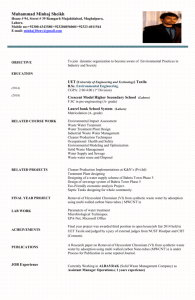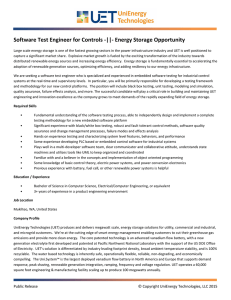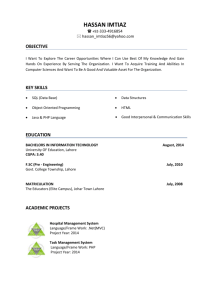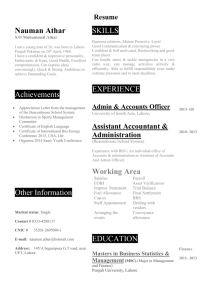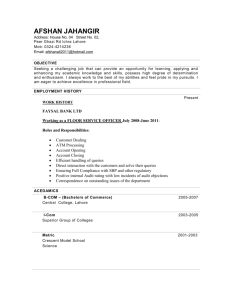seismic design
advertisement
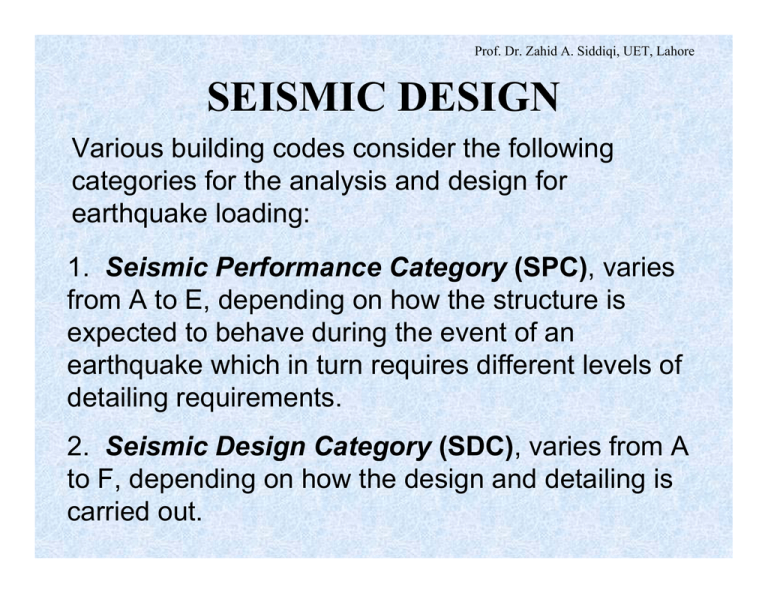
Prof. Dr. Zahid A. Siddiqi, UET, Lahore SEISMIC DESIGN Various building codes consider the following categories for the analysis and design for earthquake loading: 1. Seismic Performance Category (SPC), varies from A to E, depending on how the structure is expected to behave during the event of an earthquake which in turn requires different levels of detailing requirements. 2. Seismic Design Category (SDC), varies from A to F, depending on how the design and detailing is carried out. Prof. Dr. Zahid A. Siddiqi, UET, Lahore 3. Seismic Soil Type, varies from A to F, depending on how the waves travel through the soil. 4. Seismic Zones, 0, 1, 2A, 2B, 3, and 4, depending on the maximum design ground acceleration of a particular area. 5. Seismic Risk Categories, low, moderate, high. Prof. Dr. Zahid A. Siddiqi, UET, Lahore Low seismic risk corresponds to Seismic Zones 1 and 2A of UBC-97, Seismic design category (SDC) A and B of IBC, and Seismic performance category (SPC) A and B of NBC. Moderate / intermediate seismic risk corresponds to Seismic Zones 2B of UBC-97, Seismic design category (SDC) C of IBC, and Seismic performance category (SPC) C of NBC. High seismic risk corresponds to Seismic Zones 3 and 4 of UBC-97, Seismic design category (SDC) D, E and F of IBC, and Seismic performance category (SPC) D and E of NBC. Prof. Dr. Zahid A. Siddiqi, UET, Lahore 6. Lateral Load Resisting System, a) Intermediate moment frame — A cast-inplace frame complying with the requirements of ACI 21.2.2.3 and 21.12 in addition to the requirements for ordinary moment frames. b) Ordinary moment frame — A cast-in-place or precast concrete frame complying with the requirements of ACI Chapters 1 through 18. c) Special moment frame — A cast-in-place frame complying with the requirements of ACI 21.2 through 21.5. In addition, the requirements for ordinary moment frames should be satisfied. Prof. Dr. Zahid A. Siddiqi, UET, Lahore d) Structural walls — Walls proportioned to resist combinations of shears, moments, and axial forces induced by earthquake motions. A shear wall is a structural wall. Structural walls shall be categorized as follows: i) Intermediate precast structural wall — A wall complying with all applicable requirements of ACI Chapters 1 through 18 in addition to 21.13. ii) Ordinary reinforced concrete structural wall — A wall complying with the requirements of ACI Chapters 1 through 18. Prof. Dr. Zahid A. Siddiqi, UET, Lahore iii) Ordinary structural plain concrete wall — A wall complying with the requirements of ACI Chapter 22. iv) Special precast structural wall — v) Special reinforced concrete structural wall — A cast-in-place wall complying with the requirements of ACI 21.2 and 21.7 in addition to the requirements for ordinary reinforced concrete structural walls. Prof. Dr. Zahid A. Siddiqi, UET, Lahore Interrelationship Of Design Categories A. Low Seismic Risk corresponds to Seismic Zones 0 and 1 of UBC 97, seismic design category (SDC) of A and B (IBC), and seismic performance category of A and B (NBC). B. Moderate / Intermediate Seismic Risk corresponds to Seismic Zones 2A and 2B of UBC 97, seismic design category (SDC) of C (IBC), and seismic performance category of C (NBC). C. High Seismic Risk corresponds to Seismic Zones 3 and 4 of UBC 97, seismic design category (SDC) of D, E, and F (IBC), and seismic performance category of D and E (NBC). Prof. Dr. Zahid A. Siddiqi, UET, Lahore According to ACI 21.2.1.3, regions of moderate seismic risk or for structures assigned to intermediate seismic performance or intermediate design categories (Zones 2A, 2B), use one of the following systems or their combination to resist the seismic forces: Prof. Dr. Zahid A. Siddiqi, UET, Lahore 1. Intermediate moment frame 2. special moment frame 3. ordinary structural walls 4. intermediate structural walls 5. special structural walls Prof. Dr. Zahid A. Siddiqi, UET, Lahore According to ACI 21.2.1.4, regions of high seismic risk or for structures assigned to high seismic performance or high design category (Zones 3, 4), use one of the following systems or their combination to resist the earthquake loads: 1. Special moment frames 2. Special structural walls 3. Diaphragms and trusses Prof. Dr. Zahid A. Siddiqi, UET, Lahore GENERAL CONSIDERATIONS FOR SEISMIC DESIGN As already explained, buildings are designed to withstand moderate earthquakes without damage and severe earthquakes without collapse. Earthquake movements impose deformations on the structures. We find inertial forces due to these earthquake movements depending upon the structure. Dynamic effects like resonance are also important to be considered. Prof. Dr. Zahid A. Siddiqi, UET, Lahore Due to availability of limited data, the design is generally based on statistical studies of the previous earthquakes. As more and more earthquake data become available and understanding of the structural behavior is improved, Building Codes undergo modifications to cover the weaknesses in design criteria of the previous codes. Further, the safety of a structure subjected to earthquake loading also depends on the designer’s understanding of the response of the structure to ground motion. Prof. Dr. Zahid A. Siddiqi, UET, Lahore It is prohibitively expensive to design the structure in the elastic range. Overall structural ductility is very important in such designs. Following are the general considerations for the seismic design of structures: 1. Design for earthquakes differ from the design for gravity and wind loads particular with respect to greater sensitivity of earthquake-induced forces to the geometry of the structure. Prof. Dr. Zahid A. Siddiqi, UET, Lahore Most structures, which are not extremely tall, are designed by the equivalent static loading (up to about 20 stories). This is applicable for regular buildings with center of mass and center of resistance very near to each other. Center of Resistance Against Earthquake and Center of Mass of a Regular Structure. 8 Center of Resistance And Center of Mass Prof. Dr. Zahid A. Siddiqi, UET, Lahore The configuration of a structure has a major effect on its response to an earthquake. Structures with a discontinuity in stiffness or geometry can be subjected to very high displacements and forces. For example, the absence of shear walls, infill walls or even cladding at a particular story level, as compared to other stories, causes concentration of displacements at this story. Prof. Dr. Zahid A. Siddiqi, UET, Lahore The ground floor of a shopping center generally has this weakness. This weak story compared with rest of the structure is termed as open or soft story. The larger displacements require a considerably larger ductility at the level of soft story. If this amount of ductility is not available, the structure fails locally at this level. Such a design is not recommended and the stiffening members must be continued to the foundations. Prof. Dr. Zahid A. Siddiqi, UET, Lahore Flexible Story Prof. Dr. Zahid A. Siddiqi, UET, Lahore 2. Steps to strengthen a member for one type of loading may actually increase the forces in the member and change the mode of failure from ductile to brittle. 3. As the frequency of the ground motion becomes closer to one of the natural frequencies of a structure, the chances of the structure to experience resonance increases. 4. The first mode of vibration usually provides the greatest contribution to lateral displacement. Prof. Dr. Zahid A. Siddiqi, UET, Lahore 5. The taller structures are more affected by the higher modes of vibration and their effect actually adds to the effects of lower modes. The upper stories attract more forces due to the higher modes of vibration. 6. The longer duration of earthquake always has a greater potential for damage to the structure. 7. Vertical geometric and plan irregularities may result in torsion induced by ground motion. Prof. Dr. Zahid A. Siddiqi, UET, Lahore Opening a) Vertical Geometric Irregularities b) Plan Irregularities Geometrical Irregularities in Structures. Prof. Dr. Zahid A. Siddiqi, UET, Lahore 8. The addition of stiff members, such as shear wall, can on one side reduce the displacements of the structure and hence the damage. On the other side, stiff members pick up a greater portion of the load. When this effect is ignored in design, unexpected and often undesirable results can occur. 9. An adequate separation must be left between structures. Prof. Dr. Zahid A. Siddiqi, UET, Lahore Large lateral displacements can cause the structures to come in contact with each other during an earthquake. This results in major damage due to hammering effect. 10. Members designed for seismic loading must behave in a ductile manner and should dissipate energy without compromising the strength. Confinement of concrete is to be provided to ensure ductility in members subjected to shear and bending. Prof. Dr. Zahid A. Siddiqi, UET, Lahore Due to this confinement, the beams and columns can undergo nonlinear cyclic bending. 11. It must be tried that the plastic hinges are developed in the beams rather than columns. The weak beam – strong column approach is always preferred for the design of reinforced concrete frames subjected to seismic loading. The advantage of this approach is that the overall vertical load carrying capacity is maintained near collapse and smaller portion of the structure is affected by the nonlinear behavior. Prof. Dr. Zahid A. Siddiqi, UET, Lahore 12. Transverse reinforcement for the columns is to be carefully designed for the shear force due to lateral loads in addition to shear force resulting from the dead and live loads. A smaller length column closer to high stiffness members or shear walls may attract large shear forces and may fail in shear. This type of column, called captive column, is more critical for design in shear than in flexure. Prof. Dr. Zahid A. Siddiqi, UET, Lahore General Requirements For Moderate Risk / Intermediate Moment Frames ACI 21.12 deals with this type of frame. Reinforcement details in a frame member should satisfy ACI 21.12.4 if the factored axial compressive load, Pu, for the member is less than equal to Agfc′/10. If Pu is larger, frame reinforcement details should satisfy ACI 21.12.5 unless the member has spiral reinforcement. Prof. Dr. Zahid A. Siddiqi, UET, Lahore ACI 21.12.4 deals with beams of such frames. The positive moment strength at the face of the joint should be not less than one-third the negative moment strength provided at that face of the joint. Neither the negative nor the positive moment strength at any section along the length of the member should be less than one-fifth the maximum moment strength provided at the face of either joint. Prof. Dr. Zahid A. Siddiqi, UET, Lahore At both ends of the member, hoops should be provided over lengths equal 2h measured from the face of the supporting member toward midspan. The first hoop should be located at not more than 50 mm from the face of the supporting member. Spacing of hoops should not exceed the smallest of the following: (a) d/4; (b) 8 times the diameter of the smallest longitudinal bar enclosed; (c) 24 times the diameter of the hoop bar; (d) 300 mm. Prof. Dr. Zahid A. Siddiqi, UET, Lahore Stirrups should be placed at not more than d/2 throughout the length of the member. Columns ACI 21.12.5 deals with columns of such frames. Columns should be spirally reinforced in accordance with ACI 7.10.4 or should conform with ACI 21.12.5.2 through 21.12.5.4. Section 21.12.5.5 should apply to all columns. At both ends of the member, hoops should be provided at spacing so over a length lo measured from the joint face. Spacing so shall not exceed the smallest of (a), (b), (c), and (d): Prof. Dr. Zahid A. Siddiqi, UET, Lahore (a) Eight times the diameter of the smallest longitudinal bar enclosed; (b) 24 times the diameter of the hoop bar; (c) One-half of the smallest cross-sectional dimension of the frame member; (d) 300 mm. Length lo shall not be less than the largest of (e), (f), and (g): Prof. Dr. Zahid A. Siddiqi, UET, Lahore (e) One-sixth of the clear span of the member; (f) Maximum cross-sectional dimension of the member; (g) 450 mm. The first hoop shall be located at not more than so /2 from the joint face. Outside the length lo, spacing of transverse reinforcement should satisfy the normal spacing requirements. Joint transverse reinforcement should be provided as per ACI 11.11.2. Prof. Dr. Zahid A. Siddiqi, UET, Lahore GENERAL REQUIREMENTS FOR HIGH RISK In regions of high seismic risk or for structures assigned to high seismic performance or design categories, special moment frames, special structural walls, and diaphragms and trusses complying with ACI 21.2.2 through 21.2.8 and 21.3 through 21.10 should be used to resist forces induced by earthquake motions. Members not proportioned to resist earthquake forces should comply with ACI 21.11. Prof. Dr. Zahid A. Siddiqi, UET, Lahore Analysis And Proportioning Of Structural Members Rigid members assumed not to be a part of the lateral-force resisting system are permitted provided their effect on the response of the system is considered and accommodated in the structural design. Consequences of failure of structural and nonstructural members, which are not a part of the lateral force resisting system, should also be considered. Prof. Dr. Zahid A. Siddiqi, UET, Lahore All structural members assumed not to be part of the lateral-force resisting system should satisfy ACI 21.11. Specified compressive strength of concrete, fc ′, should be not less than 21 MPa. Reinforcement In Members Resisting Earthquake-Induced Forces Reinforcement resisting earthquake-induced flexural and axial forces in frame members should comply with ASTM A 706M. ASTM A 615M Grades 280 and 420 reinforcement should be permitted in these members if: Prof. Dr. Zahid A. Siddiqi, UET, Lahore (a) The actual yield strength based on mill tests does not exceed fy by more than 125 MPa (retests should not exceed this value by more than an additional 21 MPa); and (b) The ratio of the actual tensile strength to the actual yield strength is not less than 1.25. The value of fyt for transverse reinforcement including spiral reinforcement should not exceed 420 MPa. Prof. Dr. Zahid A. Siddiqi, UET, Lahore Flexural Members Of Special Moment Frames Factored axial compressive force on the member, Pu, should not exceed Agfc′/10. Clear span for member, ln, shall not be less than four times its effective depth. Width of member, bw, should not be less than the smaller of 0.3h and 250 mm. Width of member, bw, should not exceed width of supporting member plus distances on each side of supporting member not exceeding three-fourths of the depth of flexural member. Prof. Dr. Zahid A. Siddiqi, UET, Lahore At any section of a flexural member, except as provided in ACI 10.5.3, for top as well as for bottom reinforcement, the amount of reinforcement should not be less than that given by ACI Eq. (10-3) but not less than 1.4bwd /fy, and the reinforcement ratio, ρ, should not exceed 0.025. At least two bars should be provided continuously both top and bottom. Positive moment strength at joint face should be not less than one-half of the negative moment strength provided at that face of the joint. Prof. Dr. Zahid A. Siddiqi, UET, Lahore Neither the negative nor the positive moment strength at any section along member length should be less than one-fourth the maximum moment strength provided at face of either joint. Spacing of the transverse reinforcement enclosing the lapped bars should not exceed the smaller of d/4 and 100 mm. Lap splices shall not be used in the following situations: Prof. Dr. Zahid A. Siddiqi, UET, Lahore (a) within the joints; (b) within a distance of twice the member depth from the face of the joint; and (c) where analysis indicates flexural yielding is caused by inelastic lateral displacements of the frame. Hoops should be provided in the following regions of frame members: (a) Over a length equal to twice the member depth measured from the face of the supporting member toward midspan, at both ends of the flexural member; Prof. Dr. Zahid A. Siddiqi, UET, Lahore (b) Over lengths equal to twice the member depth on both sides of a section where flexural yielding is likely to occur in connection with inelastic lateral displacements of the frame. The first hoop shall be located not more than 50 mm from the face of a supporting member. Spacing of the hoops shall not exceed the smallest of (a), (b), (c) and (d): (a) (b) (c) (d) d/4; eight times the diameter of the smallest longitudinal bars; 24 times the diameter of the hoop bars; and 300 mm. Prof. Dr. Zahid A. Siddiqi, UET, Lahore Where hoops are not required, stirrups with seismic hooks at both ends should be spaced at a distance not more than d/2 throughout the length of the member. Prof. Dr. Zahid A. Siddiqi, UET, Lahore Special Moment Frame Members Subjected To Bending And Axial Load Discussed in ACI 21.4. The requirements of this section apply to special moment frame members (a) resisting earthquake induced forces and (b) having a factored axial compressive force Pu exceeding Ag fc′/10. These frame members should also satisfy the following conditions: Prof. Dr. Zahid A. Siddiqi, UET, Lahore The shortest cross-sectional dimension, measured on a straight line passing through the geometric centroid, should not be less than 300 mm. The ratio of the shortest cross-sectional dimension to the perpendicular dimension should not be less than 0.4. Flexural strength of any column proportioned to resist Pu exceeding Agfc′ /10 should satisfy ACI 21.4.2.2 or 21.4.2.3. Prof. Dr. Zahid A. Siddiqi, UET, Lahore Lateral strength and stiffness of columns not satisfying ACI 21.4.2.2 should be ignored when determining the calculated strength and stiffness of the structure, but such columns should conform to ACI 21.11. The flexural strengths of the columns should satisfy the following: Σ Mnc ≥ (1.2) Σ Mnb ΣMnc = sum of nominal flexural strengths of columns framing into the joint, evaluated at the faces of the joint. Prof. Dr. Zahid A. Siddiqi, UET, Lahore Column flexural strength is to be calculated for the factored axial force, consistent with the direction of the lateral forces considered, resulting in the lowest flexural strength. ΣMnb = sum of nominal flexural strengths of the beams framing into the joint, evaluated at the faces of the joint. Flexural strengths should be summed such that the column moments oppose the beam moments. The above equation is to be satisfied for beam moments acting in both directions in the vertical plane of the frame considered. Prof. Dr. Zahid A. Siddiqi, UET, Lahore Longitudinal Reinforcement Area of longitudinal reinforcement, Ast , should not be less than 0.01Ag or more than 0.06Ag. Lap splices should be permitted only within the center half of the member length, should be designed as tension lap splices, and shall be enclosed within transverse reinforcement. Transverse reinforcement required in (a) through (e) should be provided unless a larger amount is required by ACI 21.4.3.2 or 21.4.5. Prof. Dr. Zahid A. Siddiqi, UET, Lahore (a) The volumetric ratio of spiral or circular hoop reinforcement, ρs, should not be less than required by the following: ρs = 0.12 fc ′/fyt and should not be less than required normally. (b) The total cross-sectional area of rectangular hoop reinforcement, Ash, should not be less than required by the following: Ash = 0.3(sbc fc′/fyt )[(Ag /Ach) –1] Ash = 0.09sbcfc ′/fyt Prof. Dr. Zahid A. Siddiqi, UET, Lahore (c) Transverse reinforcement should be provided by either single or overlapping hoops. Crossties of the same bar size and spacing as the hoops shall be permitted. Each end of the crosstie should engage a peripheral longitudinal reinforcing bar. Consecutive crossties shall be alternated end for end along the longitudinal reinforcement. (d) If the design strength of member core satisfies the requirement of the design loading combinations including E, the above need not be satisfied. Prof. Dr. Zahid A. Siddiqi, UET, Lahore (e) If the thickness of the concrete outside the confining transverse reinforcement exceeds 100 mm, additional transverse reinforcement shall be provided at a spacing not exceeding 300 mm. Concrete cover on the additional reinforcement shall not exceed 100 mm. Spacing of transverse reinforcement shall not exceed the smallest of (a), (b), and (c): (a) one-quarter of the minimum member dimension; (b) six times the diameter of the longitudinal reinforcement; and (c) so, Prof. Dr. Zahid A. Siddiqi, UET, Lahore The value of so shall not exceed 150 mm and need not be taken less than 100 mm. Horizontal spacing of crossties or legs of overlapping hoops, hx, shall not exceed 350 mm on center. Prof. Dr. Zahid A. Siddiqi, UET, Lahore Transverse reinforcement should be provided over a length lo from each joint face and on both sides of any section where flexural yielding is likely to occur as a result of inelastic lateral displacements of the frame. Length lo should not be less than the largest of (a), (b), and (c): (a) the depth of the member at the joint face or at the section where flexural yielding is likely to occur; (b) one-sixth of the clear span of the member; and (c) 450 mm. Prof. Dr. Zahid A. Siddiqi, UET, Lahore Transverse reinforcement should extend at least the development length in tension, ld, into discontinued member. If the lower end of the column terminates on a wall, transverse reinforcement should extend into wall at least ld of the largest longitudinal column bar at the point of termination. Prof. Dr. Zahid A. Siddiqi, UET, Lahore Where transverse reinforcement is not provided throughout the full length of the column, the remainder of the column length should contain spiral or hoop reinforcement with center-to-center spacing, s, not exceeding the smaller of six times the diameter of the longitudinal column bars and 150 mm. The design shear force, Ve, is to be determined from consideration of the maximum forces that can be generated at the faces of the joints at each end of the member. Prof. Dr. Zahid A. Siddiqi, UET, Lahore These joint forces shall be determined using the maximum probable moment strengths, Mpr, at each end of the member associated with the range of factored axial loads, Pu, acting on the member. The member shears need not exceed those determined from joint strengths based on Mpr of the transverse members framing into the joint. In no case shall Ve be less than the factored shear determined by analysis of the structure. Prof. Dr. Zahid A. Siddiqi, UET, Lahore Transverse reinforcement over the lengths lo should be proportioned to resist shear assuming Vc = 0 when both (a) and (b) occur: (a) The earthquake-induced shear force represents one-half or more of the maximum required shear strength within lo; (b) The factored axial compressive force, Pu, including earthquake effects is less than Ag fc′/ 20. Prof. Dr. Zahid A. Siddiqi, UET, Lahore Prof. Dr. Zahid A. Siddiqi, UET, Lahore Prof. Dr. Zahid A. Siddiqi, UET, Lahore If columns are not stronger than beams framing into a joint, there is likelihood of inelastic action. In the worst case of weak columns, flexural yielding can occur at both ends of all columns in a given story, resulting in a column failure mechanism that can lead to collapse. When determining the nominal flexural strength of a girder section in negative bending (top in tension), longitudinal reinforcement contained within an effective flange width of a top slab that acts monolithically with the girder increases the girder strength. Prof. Dr. Zahid A. Siddiqi, UET, Lahore Prof. Dr. Zahid A. Siddiqi, UET, Lahore Joints Of Special Moment Frames Discussed in ACI 21.5. Forces in longitudinal beam reinforcement at the joint face should be determined by assuming that the stress in the flexural tensile reinforcement is 1.25fy. Strength of joint should be governed by the appropriate φ factors. Beam longitudinal reinforcement terminated in a column should be extended to the far face of the confined column core and anchored in tension and in compression according to ACI Chapter 12. Prof. Dr. Zahid A. Siddiqi, UET, Lahore Where longitudinal beam reinforcement extends through a beam-column joint, the column dimension parallel to the beam reinforcement should not be less than 20 times the diameter of the largest longitudinal beam bar for normal weight concrete. Within h of the shallowest framing member, transverse reinforcement equal to at least onehalf the amount required by ACI 21.4.4.1 should be provided where members frame into all four sides of the joint and where each member width is at least three-fourths the column width. Prof. Dr. Zahid A. Siddiqi, UET, Lahore At these locations, the spacing required in ACI 21.4.4.2 is to be increased to 150 mm. Transverse reinforcement as required by ACI 21.4.4 should be provided through the joint to provide confinement for longitudinal beam reinforcement outside the column core if such confinement is not provided by a beam framing into the joint. Prof. Dr. Zahid A. Siddiqi, UET, Lahore GENERAL PROVISIONS FOR MEMBERS NOT RESISTING EARTHQUAKES IN HIGH RISK Frame members assumed not to contribute to lateral resistance, except two-way slabs without beams, should be detailed according to ACI 21.11.2 or 21.11.3 depending on the magnitude of moments induced in those members when subjected to the design displacement δu. Prof. Dr. Zahid A. Siddiqi, UET, Lahore If effects of δu are not explicitly checked, it shall be permitted to apply the requirements of ACI 21.11.3. Where the induced moments and shears under design displacements, δu, combined with the factored gravity moments and shears do not exceed the design moment and shear strength of the frame member, the conditions of ACI 21.11.2.1, 21.11.2.2, and 21.11.2.3 should be satisfied. The gravity load combinations of (1.2D + 1.0L + 0.2S) or 0.9D, whichever is critical, should be used. Prof. Dr. Zahid A. Siddiqi, UET, Lahore The load factor on the live load, L, is permitted to be reduced to 0.5 except for garages, areas occupied as places of public assembly, and all areas where L is greater than 490 kg/m2. Members with factored gravity axial forces not exceeding Agfc′/10 should satisfy ACI 21.3.2.1. Stirrups should be spaced not more than d/2 throughout the length of the member. Members with factored gravity axial forces exceeding Agfc ′/10 should satisfy ACI 21.4.3, 21.4.4.1(c), 21.4.4.3, and 21.4.5. Prof. Dr. Zahid A. Siddiqi, UET, Lahore The maximum longitudinal spacing of ties should be so for the full column height. Spacing so should not exceed smaller of six diameters of the smallest longitudinal bar enclosed and 150 mm. Members with factored gravity axial forces exceeding 0.35Po should satisfy ACI 21.11.2.2 and the amount of transverse reinforcement provided should be one-half of that required by ACI 21.4.4.1 but should not be spaced greater than so for the full height of the column. Prof. Dr. Zahid A. Siddiqi, UET, Lahore If the induced moment or shear under design displacements, δu, exceeds φMn or φVn of the frame member, or if induced moments are not calculated, the conditions of ACI 21.11.3.1, 21.11.3.2, and 21.11.3.3 should be satisfied. Members with factored gravity axial forces not exceeding Agfc′/10 should satisfy ACI 21.3.2.1 and 21.3.4. Stirrups should be spaced at not more than d/2 throughout the length of the member. Members with factored gravity axial forces exceeding Agfc′/10 should satisfy ACI 21.4.3.1, 21.4.4, 21.4.5, and 21.5.2.1. Prof. Dr. Zahid A. Siddiqi, UET, Lahore
